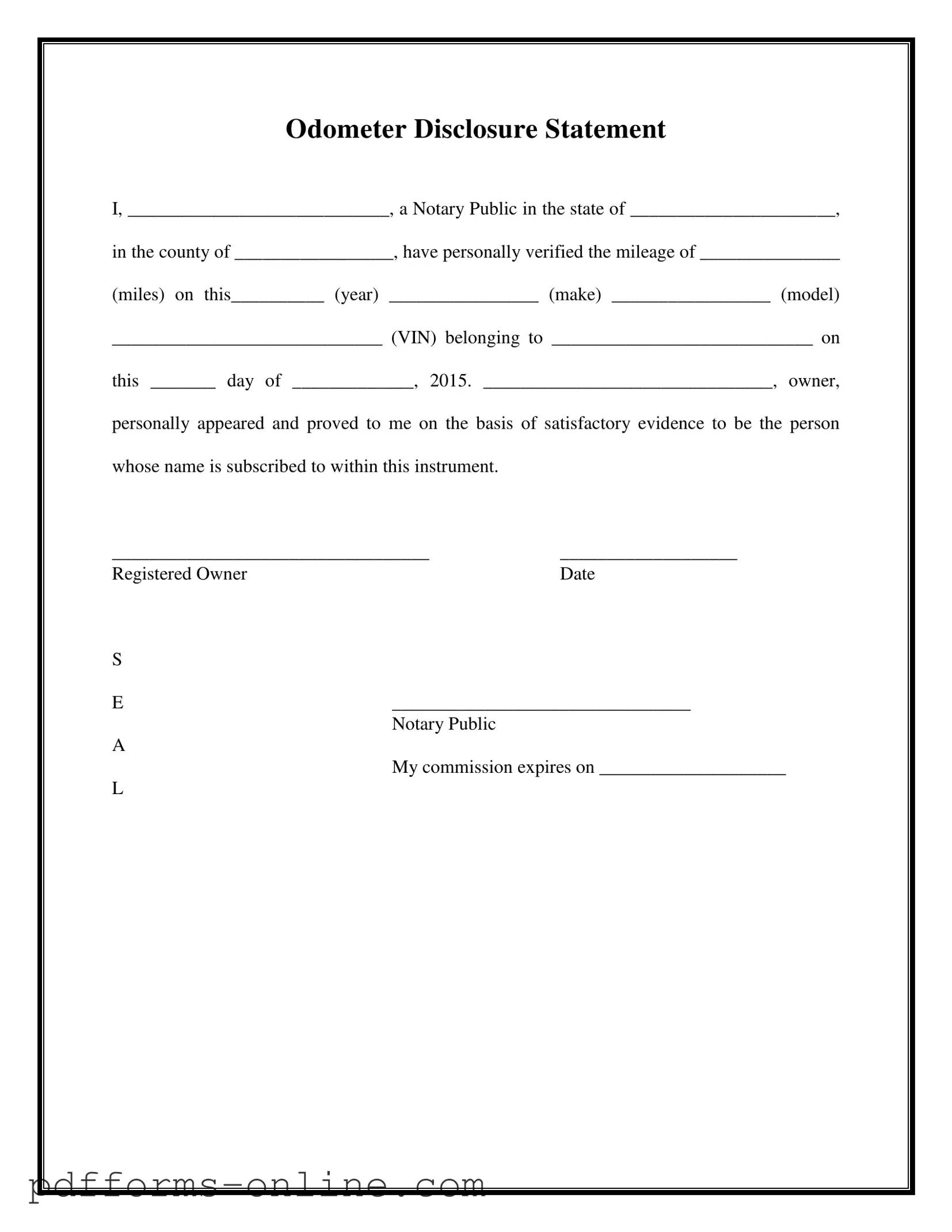The Bill of Sale is a document that serves as proof of the transfer of ownership of a vehicle from one party to another. Like the Notarized Odometer Statement, it includes essential details such as the vehicle's make, model, and Vehicle Identification Number (VIN). Both documents require signatures from the buyer and seller, and while the Bill of Sale does not necessarily need notarization, having it notarized adds an extra layer of authenticity and legal protection for both parties involved in the transaction.
The Vehicle Title is another important document similar to the Notarized Odometer Statement. It establishes legal ownership of a vehicle and includes details like the owner's name, the vehicle's VIN, and any liens against it. Both documents are crucial when transferring ownership, as the title must be signed over to the new owner, and the odometer statement verifies the mileage at the time of sale. This helps prevent fraud related to the vehicle's mileage.
The Application for Title is a form used to request a new title for a vehicle, often after purchase. This document requires information about the vehicle and the new owner, similar to the Notarized Odometer Statement. Both documents help ensure that the vehicle's history is accurately recorded and that the new owner is recognized legally. The Application for Title may also require an odometer disclosure, making it closely related to the Notarized Odometer Statement.
The Affidavit of Vehicle Ownership is a sworn statement that can be used when someone claims ownership of a vehicle but does not have the title. This document is similar to the Notarized Odometer Statement in that it requires notarization to confirm the identity of the person making the claim. Both documents help establish legal ownership and protect against fraudulent claims, ensuring that the rightful owner is recognized.
The Release of Liability form is used by a seller to notify the Department of Motor Vehicles (DMV) that they have sold a vehicle. This document is similar to the Notarized Odometer Statement because it also involves the transfer of ownership and may require the seller to provide the vehicle's mileage at the time of sale. Both documents serve to protect the seller from future liabilities associated with the vehicle after the sale.
The DMV Odometer Disclosure Statement is a state-specific form that also discloses the mileage of a vehicle at the time of sale. Like the Notarized Odometer Statement, it is designed to prevent odometer fraud and requires the seller's signature. While the Notarized Odometer Statement is verified by a notary public, the DMV Odometer Disclosure Statement may be submitted directly to the DMV, emphasizing the importance of accurate mileage reporting in vehicle transactions.
The Vehicle History Report is a document that provides information about a vehicle's past, including accidents, title issues, and mileage records. While it does not serve the same purpose as the Notarized Odometer Statement, both documents are used to ensure transparency in vehicle transactions. The Vehicle History Report can complement the odometer statement by providing a broader context of the vehicle's condition and history, helping buyers make informed decisions.
In the context of mobile home transactions, understanding the significance of the New York Mobile Home Bill of Sale form is essential, as it ensures a transparent transfer of ownership. This document can be further explored through resources such as documentonline.org/blank-new-york-mobile-home-bill-of-sale/, which provides valuable insights into the necessary details involved in the sale process.
The Power of Attorney for Vehicle Transactions allows one person to act on behalf of another in matters related to vehicle ownership. This document is similar to the Notarized Odometer Statement because it may also require notarization to confirm the identity of the person granting authority. Both documents facilitate the transfer of ownership and ensure that all parties involved are protected and informed throughout the process.
The Certificate of Title Reassignment is a form that allows the current title holder to transfer ownership of a vehicle to a new owner. This document is similar to the Notarized Odometer Statement in that it includes information about the vehicle and requires signatures from both parties. The reassignment process helps maintain accurate records of vehicle ownership and is essential for the new owner to obtain a new title.
Finally, the VIN Verification form is used to confirm the identity of a vehicle through its VIN. This document is similar to the Notarized Odometer Statement in that it helps prevent fraud and ensures that the vehicle being sold matches the documentation. Both forms play a vital role in the vehicle transaction process, providing assurance that the buyer is receiving the correct vehicle and that all necessary information is accurately recorded.

